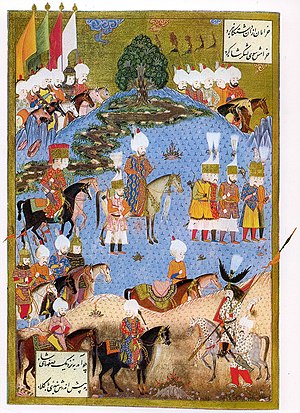Ottoman-Safavid War (1532–1555)
| Ottoman-Safavid War of 1532–1555 | |||||||||
|---|---|---|---|---|---|---|---|---|---|
| Part of the Ottoman–Persian Wars | |||||||||
 Miniature from the Süleymanname depicting Suleiman marching with an army in Nakhchivan, summer 1554, at the end of the Ottoman-Safavid War. |
|||||||||
|
|||||||||
| Belligerents | |||||||||
|
|
|
||||||||
| Commanders and leaders | |||||||||
|
|
|
||||||||
| Strength | |||||||||
| 60,000 men 10 pieces of artillery |
200,000 men 300 pieces of artillery |
||||||||
Ottomans gain large parts of Mesopotamia (Iraq), Western Kurdistan, Western Armenia, and Western Georgia
Persians retain Tabriz, Eastern Georgia, Eastern Armenia, Eastern Kurdistan, Dagestan, and Azerbaijan and the rest of their north-western borders as they were prior to the war
![]() Suleiman the Magnificent
Suleiman the Magnificent![]() Pargali Ibrahim Pasha (until 1535 when he was sent to Istanbul)
Pargali Ibrahim Pasha (until 1535 when he was sent to Istanbul)![]() İskender Çelebi (until his execution in 1535)
İskender Çelebi (until his execution in 1535)
...
Wikipedia
